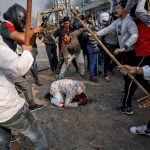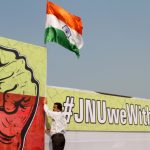Muslims fear the worst after Delhi violence
The Hindu-nationalist government seems to be fuelling the violence that erupted into anti-Muslim riots, which have been likened to the Jewish pogroms of the 1930s.
Author:
23 March 2020

The orchestrated wave of anti-Muslim violence in the northeast part of India’s capital New Delhi, which left at least 53 dead and over 200 injured, has an eerie similarity to an incident known as “Kristallnacht” during World War II. Just as Kristallnacht signalled the Nazis’ declaration of war on the Jews, the recent spate of anti-Muslim rhetoric, policies and violence indicates the prospect of mass disenfranchisement faced by India’s 200 million Muslims.
On 9 and 10 November 1938, the Nazis unleashed massive violence against Jews in Germany, Austria and the Sudetenland, supposedly in response to the assassination of a Nazi diplomat. During this pogrom, stormtroopers, Hitler Youth and ordinary Germans killed more than a hundred Jews, and looted, ransacked and destroyed thousands of Jewish institutions. In the aftermath of Kristallnacht, or the “Night of Broken Glass”, some 30 000 Jews were arrested and sent to concentration camps.
What was being witnessed on the streets of Delhi for days was a reenactment of that Nazi pogrom by India’s ruling ultra-nationalist government of Prime Minister Narendra Modi. The aim was not only to instil fear among Muslims but also to send a stern warning that any expression of dissent means death. The violence shows that Indian Muslims won’t be guaranteed the same state protection and rights as enjoyed by other groups, and that their fate is precariously linked to the whims of the Hindu population. Hundreds of Muslims fled the city with at least 5 000 now living in makeshift camps. There have also been reports that police arbitrarily picked up and charged Muslims for rioting.
Pakistan Prime Minister Imran Khan made the connection between the violence experienced by Muslims and what the Jews went through on Kristallnacht. “Images coming out of Muslim homes and businesses being burnt, Muslims being beaten and killed, mosques and graveyards being burnt and desecrated are similar to Jews fleeing the pogrom in Nazi Germany,” he said.
Related article:
As Delhi burned, neither Modi’s ruling dispensation nor the opposition parties came out to halt the violence or attempted to push the administration for prompt action. Delhi’s ruling Aam Aadmi Party (AAP) government also didn’t stop the Hindu mobs roaming the streets looking for Muslims. Modi only took to Twitter three days after the violence broke out and made a mild request for calm. In one instance, the Delhi police was accused of actively participating in rioting and helping to facilitate Hindu mobs. It failed to provide any protection to the Muslim community. It is not hard to conclude that the anti-Muslim violence was sanctioned by the state.
Delhi has a long history of violence against Muslims and rioting, which has forced the Muslim community to live in ghettoes across the city. In May 1974, violence in the north of Delhi at Sadar Bazaar left 10 people dead, while in 1984, following the assassination of Prime Minister Indira Gandhi by her Sikh bodyguards, anti-Sikh riots erupted in which more than 3 000 Sikhs were killed in the city. In May 1987, a riot in Hauz Khas left 15 dead. In the aftermath of the Babri Masjid demolition in 1992, riots erupted in Delhi’s Seelampur area in which at least 30 people were killed. The latest incident happened in 2014 when a squabble over a religious gathering turned violent in the Trilokpuri area of East Delhi, which left several dozens injured.

The contention
A protest led by a Muslim-dominated neighbourhood against the Citizenship Amendment Act (CAA) sparked the riot. The CAA has been compared to Hitler’s 1935 Nuremberg Laws, which explicitly mentioned all but “Jews” as citizens of the German state. The CAA excludes “Muslims” from the list of possible recipients of Indian citizenship.
The Indian government has already started constructing detention camps across the country for what it calls “illegal migrants”, fuelling fears among minorities, especially Muslims. In Assam, nearly two million people, mostly Muslims, found themselves missing from India’s National Register of Citizens (NRC) following which many were put into six detention centres operating in the state. Last year, India’s minister of state for home affairs told the Indian Parliament that an existing detention centre in Goalpara had 201 inmates, Kokrajhar had 140, Silchar 71, Dibrugarh 40, Jorhat 196 and the Tezpur centre held 322 inmates. The ministry also said that all states have been asked to establish detention centres according to a model detention centre manual prepared by the government. At least 100 deaths have been reported at these centres since 2008.
Related article:
There were countrywide protests against the CAA, which critics deem unfairly targets Muslims, but it was the months-long sit-in demonstrations led by elderly women in Delhi’s Shaheen Bagh locality that became the epicentre of anti-CAA protest. The movement has been a thorn in the side of Modi’s Bharatiya Janata Party (BJP) government, pro-CAA right-wing groups and the pro-Modi nationalistic media, the last of which regularly characterised the Shaheen Bagh protest either as an “international conspiracy” or as “anti-national”.
Hours before the violence broke out in Delhi, BJP leader Kapil Mishra, known for his incendiary comments, led a rally in favour of the CAA. Standing alongside senior Delhi police officials, Mishra gave a three-day ultimatum to police to clear the Shaheen Bagh demonstrations protesting the citizenship law – or face the consequences. Many activists and leaders, including left-wing leader Brinda Karat, blamed Mishra for the ensuing violence and demanded his arrest. But the BJP leadership stood behind Mishra and instead hit out at those accusing him of inciting violence.
A harsh assessment
“The carnage which engulfed the narrow lanes of a working-class settlements of Delhi for three days signals the disgraceful and comprehensive collapse of every institution of the Indian state without any exception,” wrote India’s prominent human rights activist Harsh Mander in a scathing criticism of the behaviour of state institutions backing the right-wing Hindu rioters.
Mander, in his article, wrote: “As Delhi burned, institutions looked away”, noting that among the many “public betrayals of the unfortunate survivors of the carnage”, the foremost culprit remains India’s entire political class, especially the ruling establishment of Modi, which “criminally stoked and fuelled the hatred with venomous hate speech”. “Their political project was apparent – to crush the resistance to the citizenship project and the unprecedented display of unity and solidarity across religious identities of people in this movement across the country.”
The activist castigated the police for their direct involvement in the violence, asserting the images of police taking part in the pogrom “should long rankle our conscience”, adding that vital institutions mandated to protect minorities such as the National Human Rights Commission, the National Commission for Minorities and the National Commission for Protection of Child Rights were completely missing. He also raised questions over the “intensely communalised actions” of the medical establishment. “Allegations of wanton obscuring of evidence in postmortem reports require the entire medical fraternity to reflect on what has gone so worryingly wrong in injecting the poison of communal hatred in a profession of care and healing,” he remarked.
Related article:
In a critical op-ed in a national newspaper, The Hindu, former Indian Prime Minister Manmohan Singh noted that the country has slid from being “a global showcase of liberal democracy to a majoritarian state in economic despair”, and warned that wilfully stoked communal tensions, gross economic mismanagement and an external health shock were threatening to derail India’s progress and standing. “The truth is that the current situation is very grim and morose. The India that we know and cherish is slipping away fast,” he wrote.
Indian academic and political scientist Pratap Bhanu Mehta drew a similar conclusion, asserting that India was descending into “a night of dread and despair”. He argued that the riots in Delhi were not “a tactical aberration or some absent-minded lapse of attention”. “They have been in the making for a while, and represent the future that our ruling classes, with our aid and support, have imagined for us. The idea is to carpet bomb the Indian republic as we know it, and replace it with a regime that thrives on cruelty, fear, division and violence,” he wrote.

Global outcry
As the death toll of Delhi riots rose and violence escalated, many global leaders hit out at the Indian state for failing to provide protection to Muslims. The UN high commissioner for human rights Michelle Bachelet expressed “great concern” over the police inaction during the riots, as well as over the excessive use of force by police against peaceful protestors. In similar comments, the United States Commission on International Religious Freedom also condemned the anti-Muslim violence. “We urge the Indian government to make serious efforts to protect Muslims and others targeted by mob violence,” the commission’s chairperson, Tony Perkins, said in a statement.
The UN secretary-general Antonio Guterres expressed “sadness” about the violence and invoked “the spirit of Gandhi and his principle of non-violence” to call for “the need to exercise maximum restraint and avoid violence in order to de-escalate tensions”. The Organisation of Islamic Cooperation, the second-largest intergovernmental organisation after the UN, also criticised the Indian government over the “alarming violence” against Muslims.
Related article:
Turkish President Recep Tayyip Erdoğan lashed out at India against, what he termed, the “massacre” of Muslims in India, while Iranian Supreme Leader Ayatollah Khamenei took to Twitter to condemn the violence, asserting: “The govt of India should confront extremist Hindus and their parties and stop the massacre of Muslims in order to prevent India’s isolation from the world of Islam”. This was followed by a strongly worded statement by Iranian foreign minister Javad Zarif, who termed the riots “organised violence against Indian Muslims”, and calling upon Delhi to “not let senseless thuggery prevail”.
In the UK’s House of Commons, Labour, the Scottish National Party, Liberal Democrats and Conservative MPs criticised the Indian government and urged the British government to take strong action. Labour Party member Nadia Whittome announced her rejection of the words “clashes” or “protest” in reference to the violence in Delhi and went on to say that the events represent “a continuation of sustained and systemic Hindutva violence waged on Muslims and many minority ethnic communities in India that is sanctioned by Modi’s BJP government”. The United States was mild in its criticism, urging Delhi to respect the right to peaceful protest and has urged all sides to refrain from violence.





